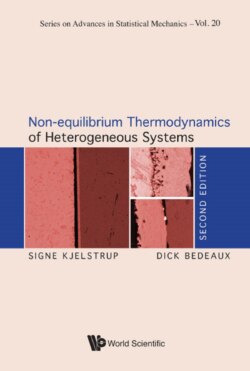Читать книгу Non-equilibrium Thermodynamics of Heterogeneous Systems - Signe Kjelstrup - Страница 25
3.A.2The surface
ОглавлениеThe Gibbs equation for the surface is
| (3.55) |
In this expression, Us, Ss, Nis, Ps are extensive quantities, which are proportional to the surface area. These extensive quantities were obtained as excesses of the corresponding three-dimensional densities. The variables Ts, γ, μis, Dseq are intensive variables of the surface, indicated by superscript s. The temperature, surface tension, chemical potentials and the displacement field are intensive variables and have no excesses.
By integration, with constant surface tension, temperature, composition and displacement field, we obtain
| (3.56) |
The Gibbs energy can now be defined by
| (3.57) |
By using Gibbs equation again, we have
| (3.58) |
The chemical potential obtains two equivalent definitions from these relations:
| (3.59) |
where μjs = Gjs. The superscript indicating the surface has been dropped in the subscripts of the differentiation. By using Maxwell relations for the definition of Gs, we find the following expressions for the partial molar quantities:
| (3.60) |
This results in the following expression for a change in the chemical potential
| (3.61) |
The following combination is frequently used in expression (4.15) for the entropy production and flux equations that derive from this:
| (3.62) |
Alternative expressions are as follows:
| (3.63) |
The partial molar surface area, the partial molar entropy and the partial molar polarization for the surface are, respectively:
| (3.64) |
Furthermore, we have
| (3.65) |
By using the partial molar quantities defined above, one may also define the partial molar internal energy and enthalpy
| (3.66) |
where these functions, according to the above construction, are functions of γ, Ts, γk and (Dseq/ε0).
Exercise 3.A.1.Find a form of Gibbs–Duhem’s equation for the surface that contains dμsj, T instead of dμjs.
•Solution: If we substitute Eq. (3.62) into Eq. (3.32d), we have
By using , Gibbs–Duhem’s equation for the surface is reduced to
